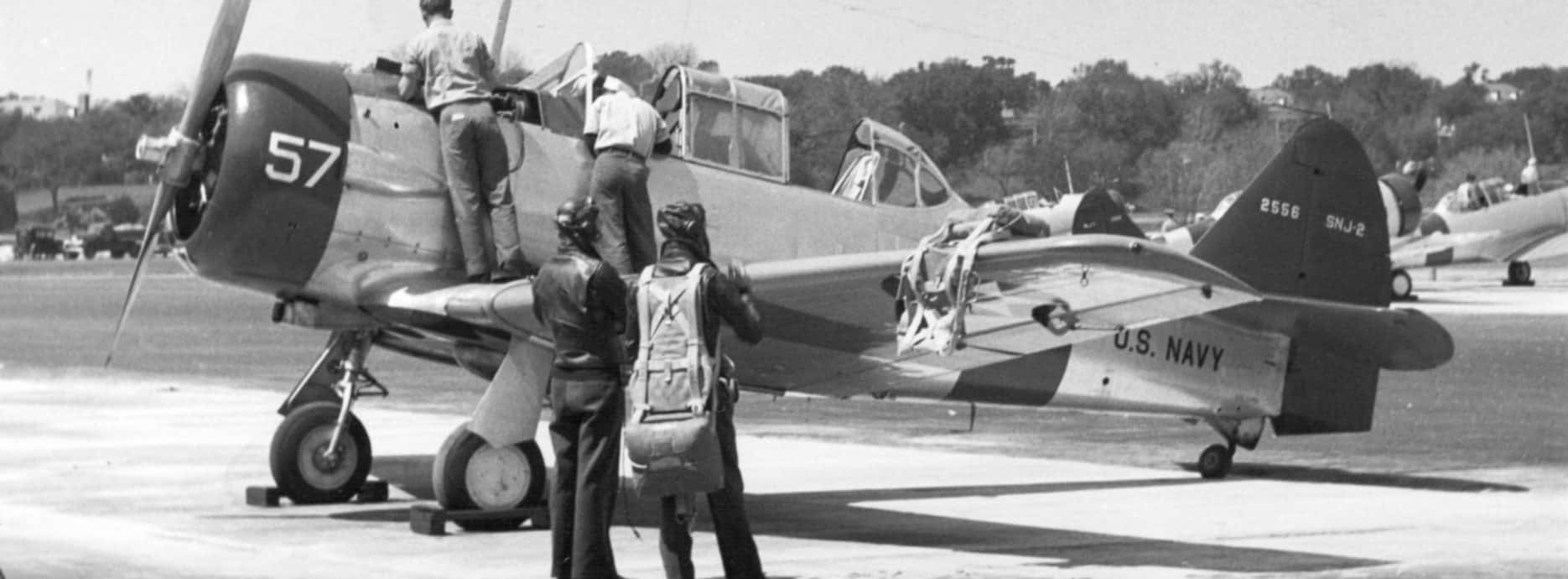

By Linda Batchelor
The Bartlett Maritime Research Centre & Library at the National Maritime Museum Cornwall was recently the setting for reuniting a set of a Cornish pilot’s ‘Wings’ from World War II with surviving members of his family.
The reunion was the result of a chance discovery of a small document wallet in a second-hand book about Cornish history and the involvement of Simon Turner, an ex-helicopter pilot in the RAF and now one of our Library Volunteers, who undertook the research which made it all possible.
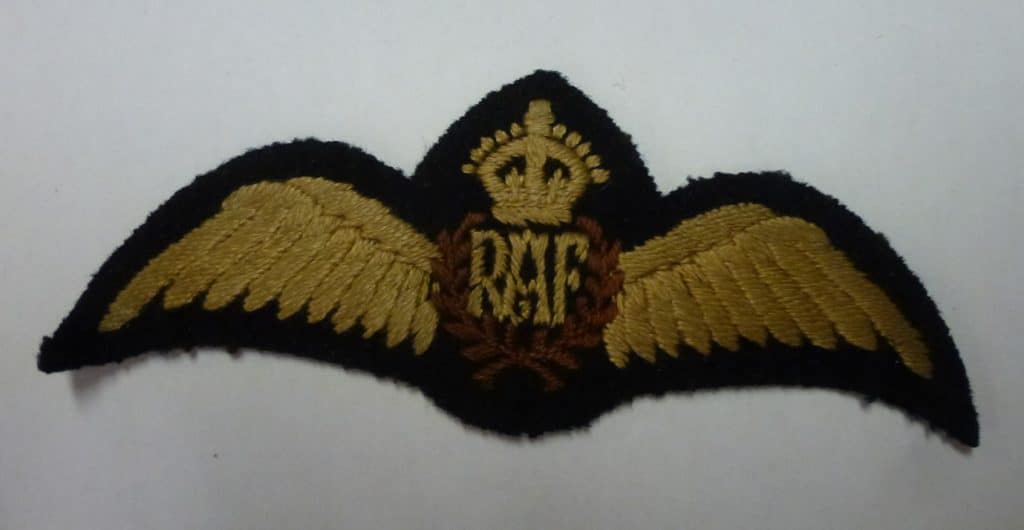
Benjamin Uren’s Flying Badge – known as a pilot’s ‘Wings.’
The recipient of this set of ‘wings’ was Benjamin (Ben) Uren who was born in Redruth on 12 November 1923.
As a schoolboy in Camborne, Benjamin won county caps in both rugby and football and at the beginning of the war in 1939 he was living with his parents in Beacon, Camborne, and was an electrician’s apprentice. Later in the war he joined the RAF and, after basic training in Britain, he was sent to Pensacola, Florida, in the USA as a Sergeant Pilot for flying training.
He returned to Cornwall at the end of the war and resumed his rugby playing, often featuring in local newspaper reports as a talented player for several local rugby teams. In October 1952, when he is recorded as living at Wall Farm in Gwinear, near Hayle, he married Kathleen Johns in Penzance.
Benjamin died in Falmouth in 1986.
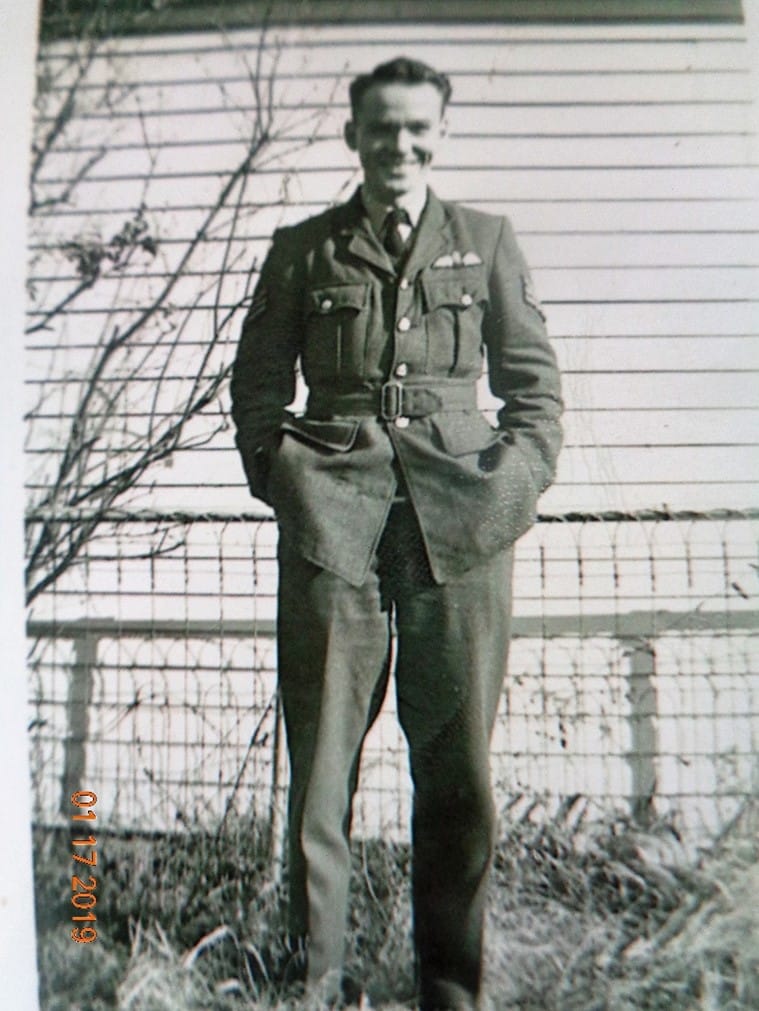
Benjamin Uren wearing his RAF Pilot ‘Wings’ circa 1944.
It was a friend of Simon Turner who found the document wallet with the ‘Wings’ and other small articles of memorabilia from Benjamin’s time in flying training. He had purchased the second-hand book on Cornish history, and the wallet was tucked inside the pages of the book. He passed the wallet to Simon, knowing of Simon’s successful career in the RAF and his continued interest in all aspects of flying.
Simon told our volunteer group the story of the find and brought the wallet to the Library to show us. It has never been clear how the wallet had found its way into the book but the fact that the items had obviously been kept together from the time when Benjamin had undertaken his flying training and qualification as a pilot indicated the value he had placed upon them.
We were all intrigued by the story and the connections with Cornwall and a Cornish pilot trained at a United States Naval training station. Simon decided to do research into the pilot and his training to try to find a connection so the wallet and its contents could be returned.
As well as the RAF flying badge, there were a variety of other documents which related to the time Benjamin spent in training in Pensacola, which clearly had significance for him.
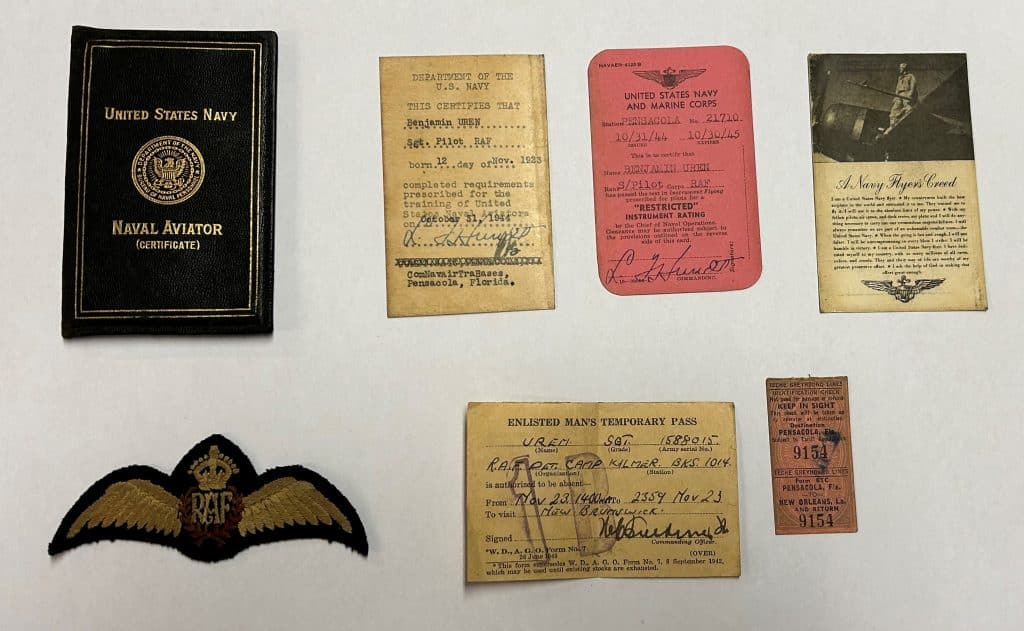
The Wallet, the RAF ‘Wings’ and Contents.
The wallet shown in the photograph which belonged to Benjamin was issued by the United States Navy and designed to take a Naval Aviator’s Certificate.
Next to the wallet is Benjamin’s Naval Aviator’s Certificate which states he had completed training as a naval aviator dated October 31 1944, at Pensacola Naval Air Training Base.
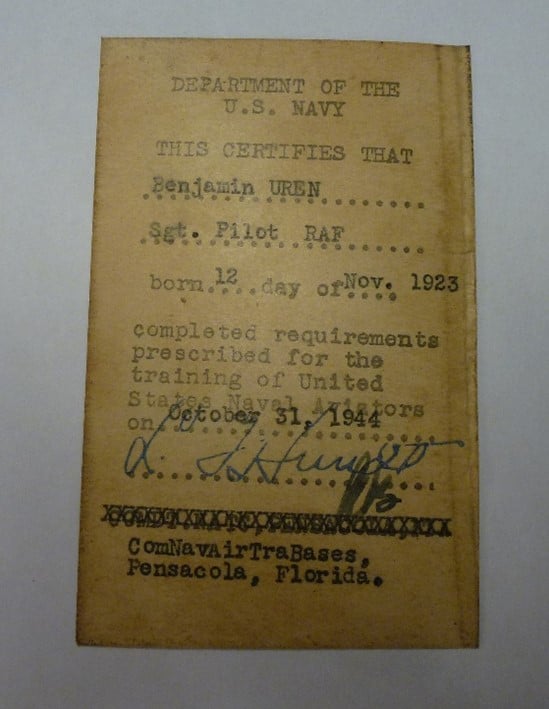
Pilot/Naval Aviator’s Certificate.
The pink Certificate for Instrument Flying was also issued at Pensacola and beside it is the United States Navy Flyers Creed. The American metal ‘Wings’ are shown on the Creed and these were awarded to RAF pilots alongside RAF ‘Wings’.
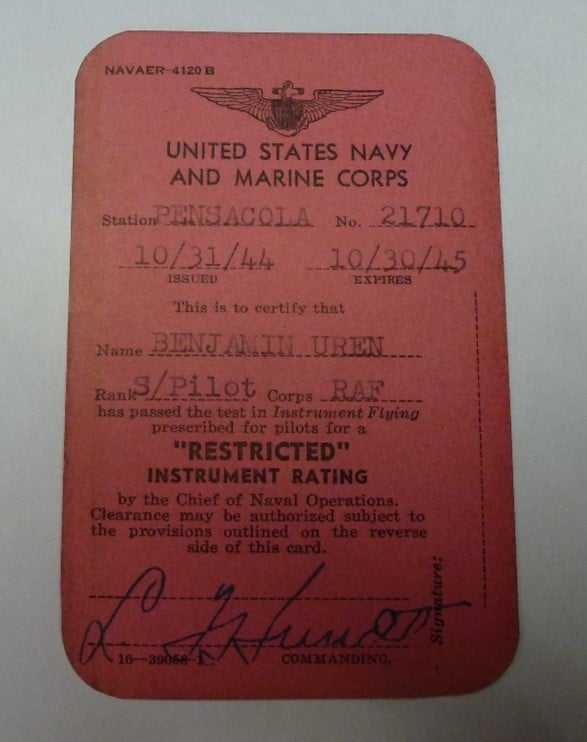
A photo of the pink Instrument Flying Certificate.
The remaining two items are a Greyhound Bus ticket stub for a return journey from Pensacola to New Orleans, and a Temporary Pass issued to Benjamin at Camp Kilmer on 23 November 1943 for a visit to New Brunswick.
Camp Kilmer was a major transportation hub for United States troops being shipped to Europe and was also used for Allied units entering the eastern United States before being sent for training elsewhere. This would have included the RAF and Fleet Air Arm pilots being sent to various training venues including Pensacola.
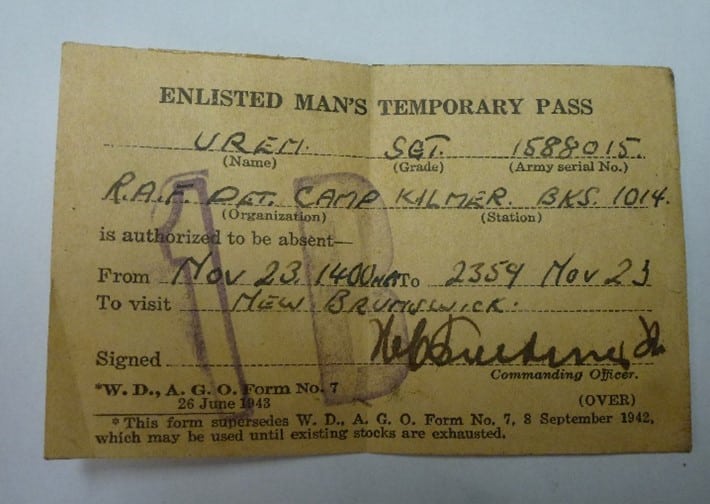
The Pass for a visit to New Brunswick
When Florida was ceded by Spain to the United States in 1821, the United States government decided to use Pensacola harbour on the Florida coast as a major naval base known as the Pensacola Navy Yard.
In 1911 it became the first US Naval site to be designated as a Naval Air Station and in 1914 the Navy established an aviation training centre there. The Naval Air Station (NAS) Pensacola became known as the ‘Cradle of Naval Aviation’ in the United States and by 1935, when the Aviation Cadet Training Program began at Chevalier Field, it was a hub of naval air training activities, particularly pilot training.
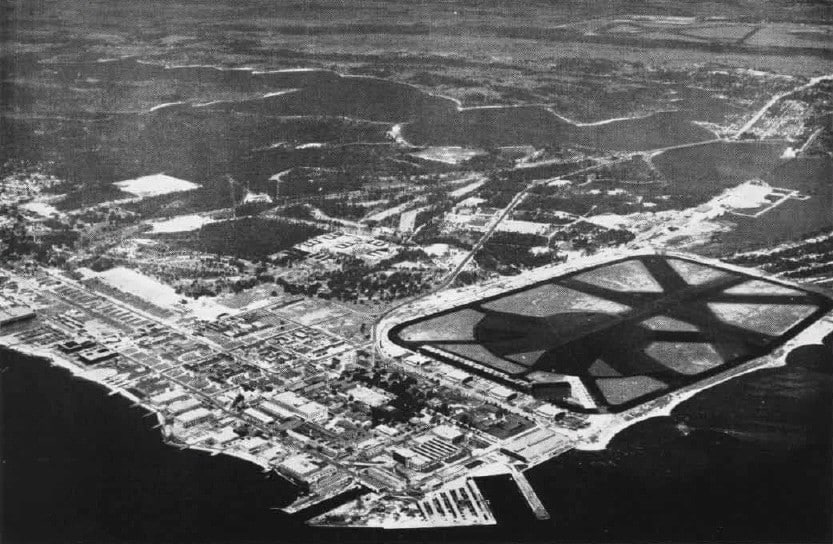
Aerial View of the Naval Air Station Pensacola with the Airfield known as Chevalier Field in 1947.
© US Naval Aviation News 1948.
The United States was not combatant at the start of World War II or during the early years of the conflict but did assist Great Britain with the lend-lease scheme for ships and equipment. In 1941 two schemes were introduced to assist with aviation training. The first was proposed in March 1941 by Major-General Arnold, Chief of the US Army Air Corps, who in April made the Royal Air Force the offer of one third of the US Army’s pilot training capacity. The Arnold Scheme was swiftly followed in June 1941 by the Towers Scheme when Admiral Towers, Chief of the US Bureau of Aeronautics, offered the British the use of US Naval facilities to train pilots, observers and wireless operators for the Royal Air Force and the Fleet Air Arm.
The first British cadets arrived at Pensacola just five weeks later. By the end of the War, the NAS had trained over 28,000 naval aviators and amongst them 2,775 British pilots, for the RAF and the Fleet Air Arm. Benjamin Uren was one of that number. In 1991 a monument was dedicated outside Base Headquarters to the British and Commonwealth aviators trained at Pensacola.
The Naval Air Station at Pensacola was a base for Catalina Flying Boats and carrier aircraft, and training was mainly undertaken using the SNJ-1 and SNJ-2 Texan aircraft. After training, RAF pilots were destined to fly a variety of aircraft and flying duties in Fighter, Bomber and Coastal Command whilst the Fleet Air Arm pilots were trained mainly for duty with carrier aircraft and flying boats such as the Sunderland.
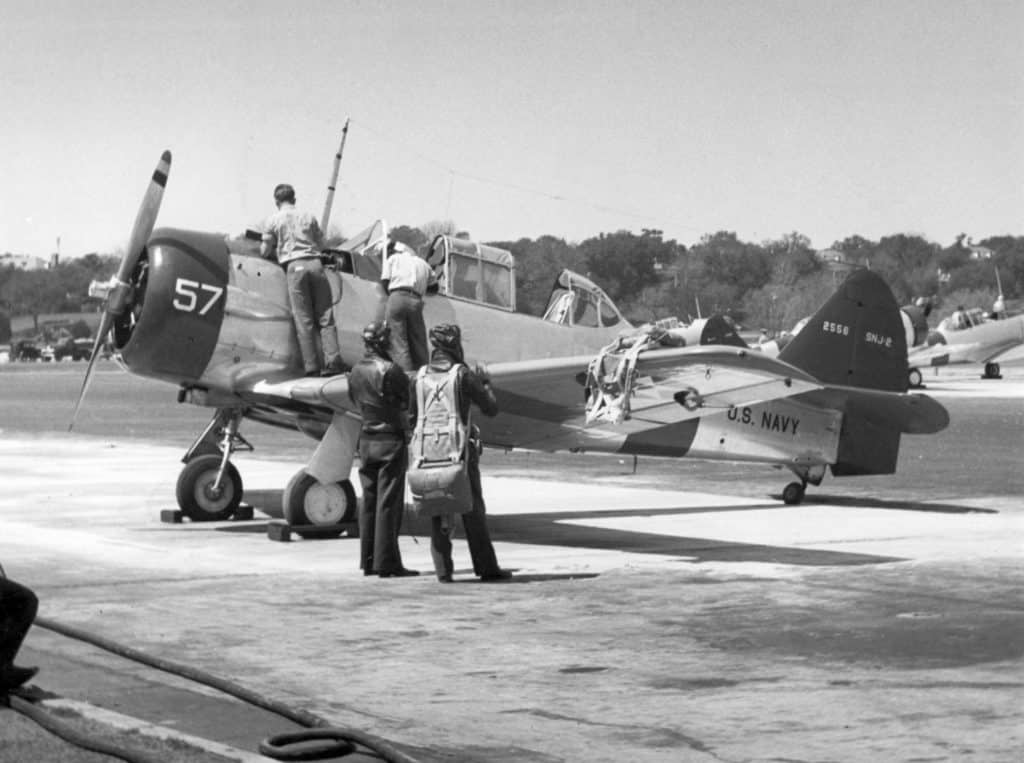
A SNJ-2 Aircraft prepared for a training flight at Pensacola in 1942.
© US Navy National Museum of Naval Aviation.
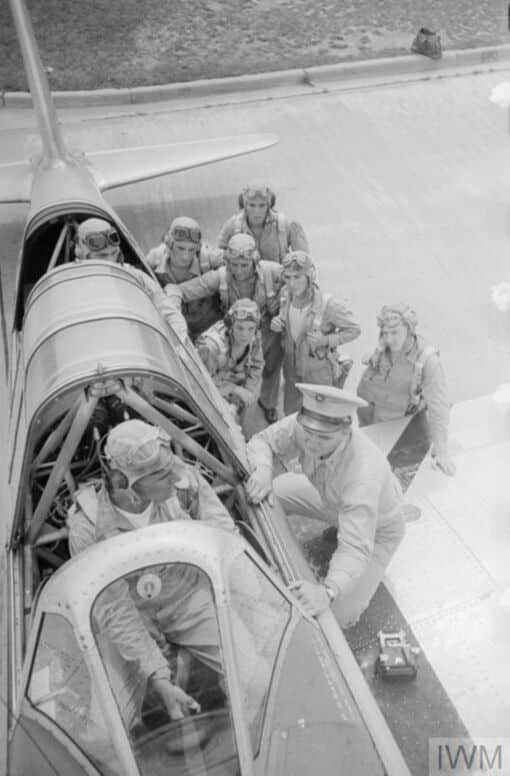
2nd Lieutenant Sweet of the US Marines gives instruction
to a group of British cadets under training at Pensacola.
© Imperial War Museum.
The airbase at Pensacola covered over 30 square miles with a vast number of buildings. There were four airfields for land planes and three waterways for sea planes and flying boats. The base had a shopping centre, restaurants, cinemas, sporting facilities and its own bus service. The weather in Florida was warm, there were beaches close to the base and food was plentiful including the delights of ice cream and Coca-Cola. Nevertheless, despite the comforts, discipline was strict and the training programme was rigorous and demanding.
Undoubtedly for the RAF and FAA trainees, the difference from war-torn Europe must have been an enormous contrast and it must also have been a tremendous experience for many.
Simon Turner decided that he would try to reunite the wallet with the original owner’s family and so embarked on research to find them. Using our Library access to Ancestry, he was able to trace Ben’s birth and other events such as his marriage and his death. He was also able to connect with surviving family members via family tree information provided by Paul Bowman.
When Simon made contact with Paul, his response was positive and he explained that both he and his mother, a surviving relative of the same generation as Benjamin, would be delighted to take care of the find. Paul does not live in Cornwall but his mother is still resident near Falmouth, and he agreed to visit the Museum and the Bartlett Library to view and collect the wallet and its contents.
In July 2023 Paul came to see us and received the wallet. He met Simon and the Library volunteers together with the Museum’s curatorial and marketing teams to hear about the find and filled us in with some more details of the story. The visit was recorded with photographs for the Museum’s archives.
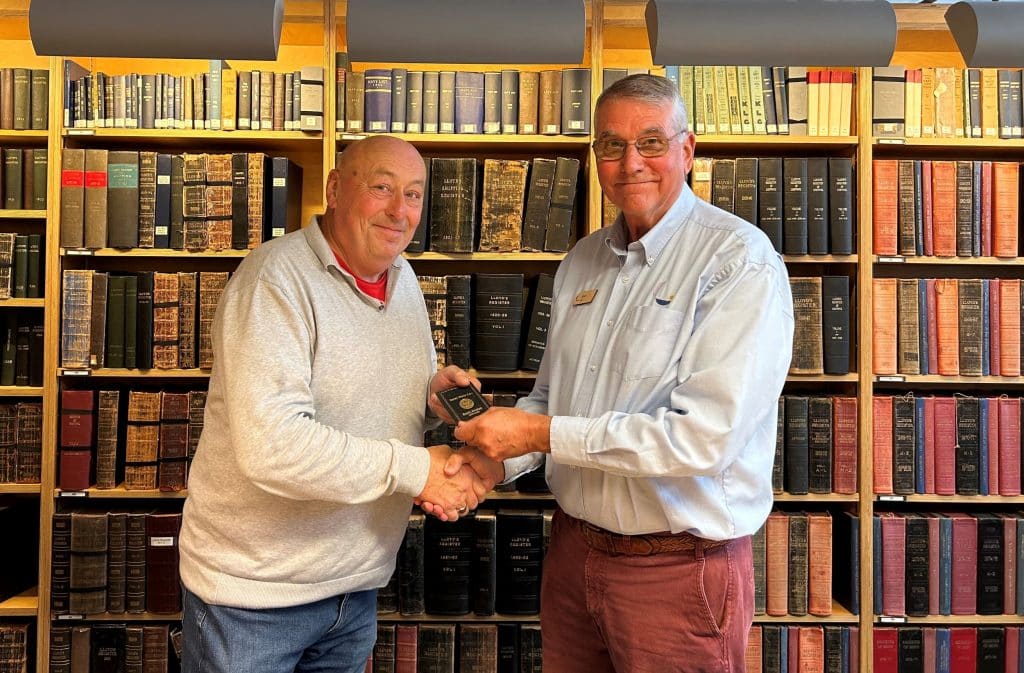
Paul Dowman, here on the left, receiving the wallet from Simon Turner in the Bartlett Maritime Research Centre and Library of National Maritime Museum Cornwall.
This small discovery of the wallet from World War II saved what was obviously some cherished memorabilia of Serjeant Pilot Benjamin Uren and reunited it with surviving family members. With its Cornish connexion and the links to RAF and naval aviation training in the United States, it also opened up an interesting area of research for the volunteers in the Bartlett Maritime Research Centre and Library adding more information to our extensive archive.
The Bartlett Blog is written and produced by the volunteers who staff The Bartlett Maritime Research Centre and Library of National Maritime Museum Cornwall. This blog post was written by Linda Batchelor, a Bartlett Library volunteer.
The Bartlett Maritime Research Centre & Library holds a Collection of over 20,000 volumes and offers access to one of the finest collections of maritime reference books, periodicals and archival material. The Bartlett Blog reflects the diversity of material available in The Bartlett Library.

National Maritime
Museum Cornwall Trust
Discovery Quay
Falmouth Cornwall
TR11 3QY
View Map
See our opening hours
Tel: +44(0)1326 313388
Email: enquiries@nmmc.co.uk